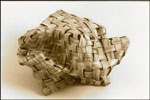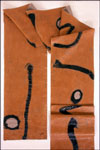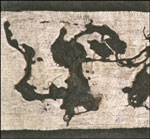Uplift and Erosion
A Collection of Like Things
Opening Reception: Saturday, April 8, 5 p.m.
Exhibit remains through April 24th
Coleman Auditorium
 Uplift and Erosion: A Collection of Like Things, is an exhibit by Suzan Friedland, Joost Romeu, and Kim Shuck using fabric paper, clay, threads, hemp, wood, sand and other natural elements that are not commonly thought of as artists' materials, but which, combined in the hands of artists can carry and express artistic ideas.
Uplift and Erosion: A Collection of Like Things, is an exhibit by Suzan Friedland, Joost Romeu, and Kim Shuck using fabric paper, clay, threads, hemp, wood, sand and other natural elements that are not commonly thought of as artists' materials, but which, combined in the hands of artists can carry and express artistic ideas.
 The exhibit will be in the Coleman Auditorium, from April 8 through April 24. A combined opening reception will be April 8 from 5 p.m. to 7 p.m. for this exhibit plus the Baulines Craft Exhibit in the Burnett Gallery and the Broad(er)sides exhibit in the Jacob Foyer.
The exhibit will be in the Coleman Auditorium, from April 8 through April 24. A combined opening reception will be April 8 from 5 p.m. to 7 p.m. for this exhibit plus the Baulines Craft Exhibit in the Burnett Gallery and the Broad(er)sides exhibit in the Jacob Foyer.
 Suzan Friedland, from San Francisco, is known for her large textile works incorporating linen, horse manure, straw, and clay on panels which are often quilted. Joost Romeu, from New York City, uses strings and thread, wood and branches to convey abstract ideas into a new reality. Kim Shuck, also from San Francisco, uses weaving, twining, and braiding techniques to bring Native American concepts to a new visual authenticity. Both Romeu and Shuck are published poets so language is an important part of their works also.
Suzan Friedland, from San Francisco, is known for her large textile works incorporating linen, horse manure, straw, and clay on panels which are often quilted. Joost Romeu, from New York City, uses strings and thread, wood and branches to convey abstract ideas into a new reality. Kim Shuck, also from San Francisco, uses weaving, twining, and braiding techniques to bring Native American concepts to a new visual authenticity. Both Romeu and Shuck are published poets so language is an important part of their works also.
Uplift and Erosion
An interview with Joost Romeu
Jane Reichhold: To bring readers up to speed on this, let me begin by saying that you, Suzan Friedland, and Kim Shuck are having an exhibit titled "Uplift and Erosion: A Collection of Like Things" in the Coleman Auditorium of Gualala Arts opening on Saturday, April 8 and running through April 24. How many pieces have you prepared for the show?
Joost Romeu: I'm planning to show 18 pieces: eight of them a "Circle Series"; two "Reconstructions". All but three will be wall mounted; three - including a diptich - are "framed" pieces.
JANE: Help me with this, Joost. I think I understand concept art, especially since admiring the genre since seeing art provera in the sixties, but it seems to me you are taking this method to a new level by employing art to solve problems. Is this how you see your work?
JOOST: Like many artists tagged with the moniker "conceptual artist", I chaffed when it was applied to me in my 60/70's New York City years. Problem was, conceptual art came to be equated with art that one could just as easily read-about or think-about as actually take the time and effort to experience. Lot of "heady" things go on in science. But when the rubber has to meet the road every scientific "fact" has to be "experienced" - an experiment has to be conducted and someone has to be present to actually see the needle on the meter jump, or read the resulting data. In like manner, the experience of my work (and all art) requires that a person be present to do the experiencing, no matter how "conceptual" the work may seem. Though I thought much of the best work at the time was the stuff called "conceptual", my interests were just as taken with the minimal and process work of the same era, and you can see these concerns in my art.
I also enjoy experiments, whether it's discovering if you can tell the difference between Pepsi and Coke blindfolded (you can't - add a 7-Up sample and you can't either!); if you have to add all the ingredients for chocolate chip cookies in the right order (you do!); or if I can to set up a problem; think about it; and solve that problem with no hitches... Invariably (and often in direct proportion to how much I've thought about it) the fabrication of a piece brings up more problems than I could have imagined and the completion of that problem more realizations and recognitions than I could have hoped for. And that's great.
JANE: Do you see your work as beyond, or outside of, esthetics? Is there a point at which you would bend your hypothesis to make the end product more attractive?
JOOST: I see esthetics as a developing attitude toward the things we encounter in life. Like most things that develop, as much as we'd sometimes like it to be a way we'd experienced before, esthetic identity is always in the state of becoming (differently interesting, differently beautiful, differently this or that, depending on the subject's proclivities). Actually it's quite easy to "create" things that look aesthetically inspired. Frame a painting and slap it behind glass and it automatically seems to go up in "(esthetic) value" (although supplying a frame, typically has no relationship to what you were doing when you were painting). Unfortunately, these decorative affectations tend to be what causes a work to sell more easily.
I prefer to be thrilled and surprised by the things I find attractive than to "bend my hypothesis" so as to support some preconception of beauty. I prefer the engaging surprise.
JANE: Understanding how vital your original idea is to the finished piece, how necessary is it that the viewers know your mental and physical processes to enjoy the work?
JOOST: It's not necessary at all. I see many things around me that I enjoy and for which I've not been granted the opportunity to know their progenitor "mental and physical processes". It's not that I wouldn't like to know. I tend - when meeting anyone - to ask scads of questions about who they are and what they do. It doesn't endear me to everyone - no matter, it's a convenient way to separate the "we (human family) from the chaff" (those only willing to sell what they think).
JANE: How important are your titles and how do you come to name the works?
JOOST: I saw a TV program about a collector who - when displaying the work he'd bought - refused to display any labels with the pieces. My first thought was: "Hmmm. Maybe I could make a piece for him that would require a label..." My second was to realize that the reason my titles seem to say so very little is not that they don't want to detract from the work but that they want to let in more of the viewer. (You might ask: "What are those letters appearing after the 'underbar' in the title? They're my personal way of remembering the piece - kind of like the endearing things you call a loved one but wouldn't want to in public. I would never display them in full - folk would use them as an excuse to not "look". But ask me at the show and I'll be happy to tell you what they signify.)
So why the accompanying text? That collector again...I just couldn't resist telling people more about the piece - as part of a dialog, not all of a label - and thus, in a way that doesn't get in the way of the work.
Incidently, you wanted photos to accompany this interview. My work tends to photograph very badly. To its credit. My sculpture is sculpture; my paintings, paintings. They simply don't work as photographs.How easy is it to photograph "Sunset": (a previous GAC show piece) a six foot long piece of thread hanging between two nails and accurately painted the colors of the sunset. Experiencing the piece is similar to seeing the infamous 'green flash' that happens milliseconds after the sun (actually) sets. It's quite rewarding. But not photographable. So why fill an interview space with 1000-meaningless-words when you can stock it with a few interesting thoughts. I just hope people will come and experience the work.
JANE: It seems very apropos that you are, not only artist, but also a poet so that words and ideas are an important part of the final result. Having this show in April, when we are celebrating poetry, and having it open 5 - 7 p.m., just before the poetry reading of Jane Hirshfield at 7:30 shows makes it convenient for visitors to take in both events at once.
JOOST: And the poetry "Broadersides" show opening. It's an honor to be able to mount so much of our community's poetic inventiveness (incidently the "community" contributing to Roots & Branches has - this year - extended to both coasts) and to be able to show my work in a venue hosting Ms. Hirshfield. Words are no less 'material' than what's involved in painting and sculpture; they're no less 'conceptual"; involve no less an involvement with process; and can be just as minimal or adorned as any other human endeavor. It's good that they be juxtaposed.
Gualala Arts Center is located
at 46501 Old State Highway in Gualala, and is open from 9 am to 4 pm weekdays,
and weekends from noon to 4 p.m. Please call (707) 884-1138 for more information.

 Uplift and Erosion: A Collection of Like Things, is an exhibit by Suzan Friedland, Joost Romeu, and Kim Shuck using fabric paper, clay, threads, hemp, wood, sand and other natural elements that are not commonly thought of as artists' materials, but which, combined in the hands of artists can carry and express artistic ideas.
Uplift and Erosion: A Collection of Like Things, is an exhibit by Suzan Friedland, Joost Romeu, and Kim Shuck using fabric paper, clay, threads, hemp, wood, sand and other natural elements that are not commonly thought of as artists' materials, but which, combined in the hands of artists can carry and express artistic ideas.
 The exhibit will be in the Coleman Auditorium, from April 8 through April 24. A combined opening reception will be April 8 from 5 p.m. to 7 p.m. for this exhibit plus the Baulines Craft Exhibit in the Burnett Gallery and the Broad(er)sides exhibit in the Jacob Foyer.
The exhibit will be in the Coleman Auditorium, from April 8 through April 24. A combined opening reception will be April 8 from 5 p.m. to 7 p.m. for this exhibit plus the Baulines Craft Exhibit in the Burnett Gallery and the Broad(er)sides exhibit in the Jacob Foyer.
 Suzan Friedland, from San Francisco, is known for her large textile works incorporating linen, horse manure, straw, and clay on panels which are often quilted. Joost Romeu, from New York City, uses strings and thread, wood and branches to convey abstract ideas into a new reality. Kim Shuck, also from San Francisco, uses weaving, twining, and braiding techniques to bring Native American concepts to a new visual authenticity. Both Romeu and Shuck are published poets so language is an important part of their works also.
Suzan Friedland, from San Francisco, is known for her large textile works incorporating linen, horse manure, straw, and clay on panels which are often quilted. Joost Romeu, from New York City, uses strings and thread, wood and branches to convey abstract ideas into a new reality. Kim Shuck, also from San Francisco, uses weaving, twining, and braiding techniques to bring Native American concepts to a new visual authenticity. Both Romeu and Shuck are published poets so language is an important part of their works also.